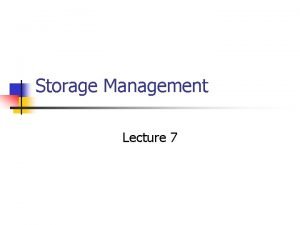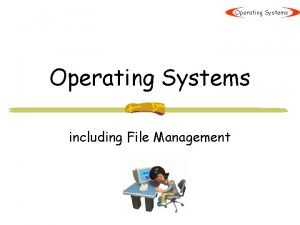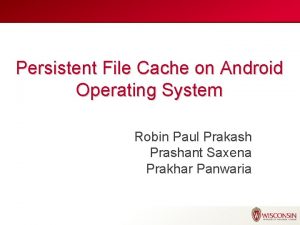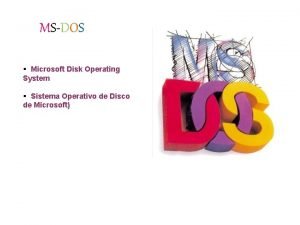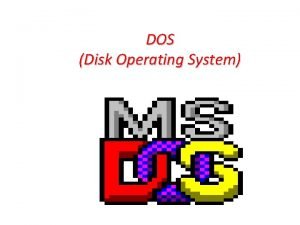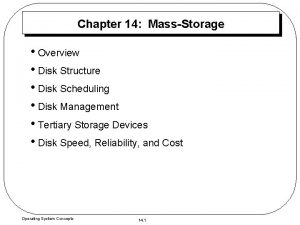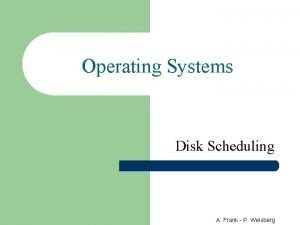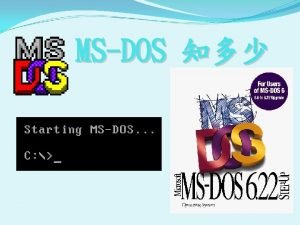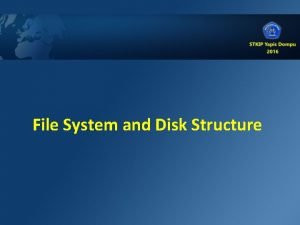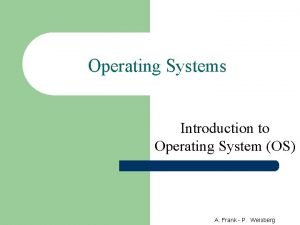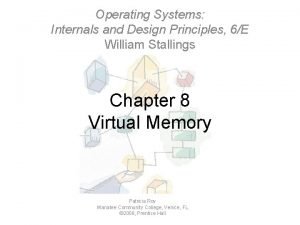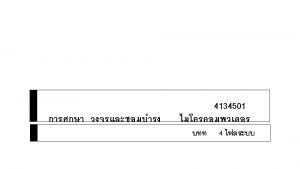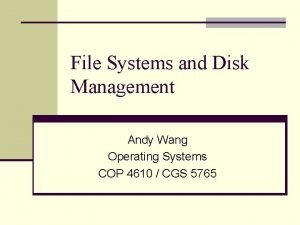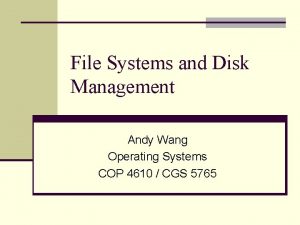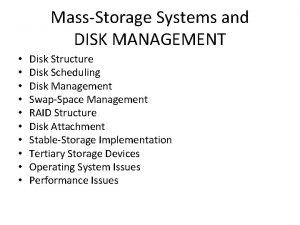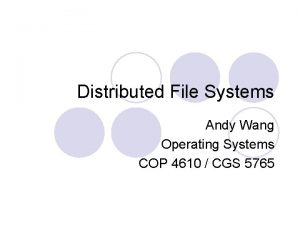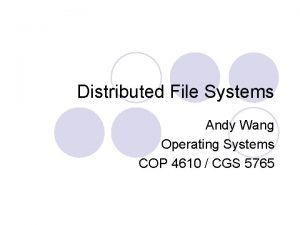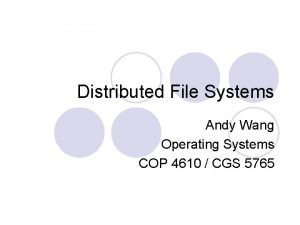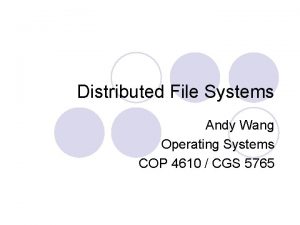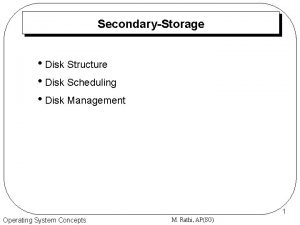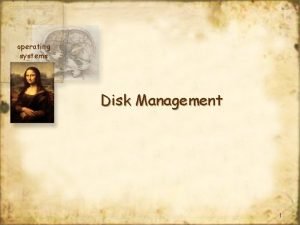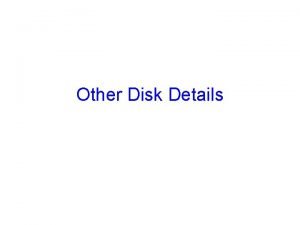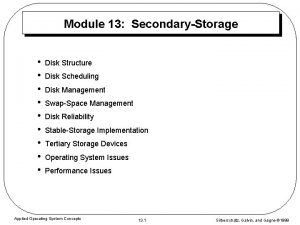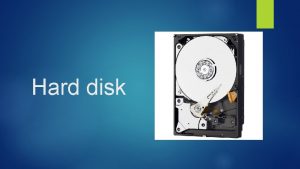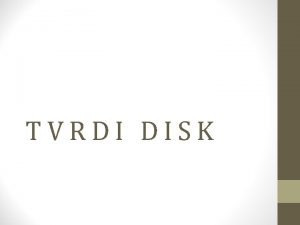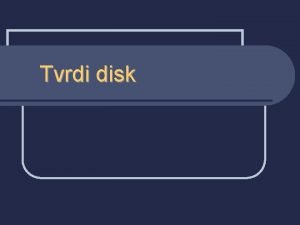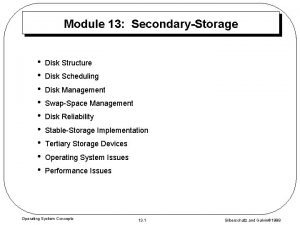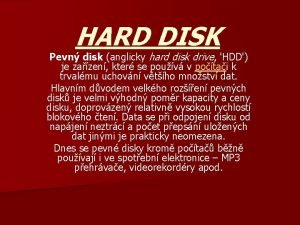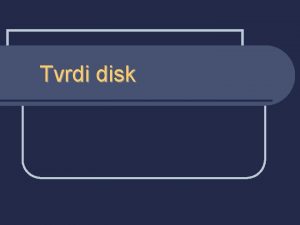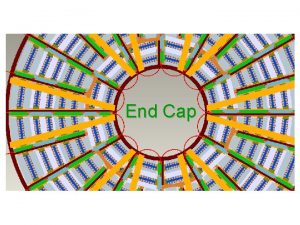File Systems and Disk Management Andy Wang Operating

























- Slides: 25

File Systems and Disk Management Andy Wang Operating Systems COP 4610 / CGS 5765

Design Goals of File Systems Physical reality File system abstraction Block-oriented Byte-oriented Physical sectors Named files No protection Users protected from one another Robust to machine failures Data might be corrupted if machine crashes

File System Components n Disk management organizes disk blocks into files n Naming provides file names and directories to users, instead of tracks and sector numbers (e. g. Takashita) n Protection keeps information secure from other users n Reliability protects information loss due to system crashes

User vs. System View of a File n User level: individual files n System call level: collection of bytes n Operating system level: n A block is a logical transfer unit n n Even for getc() and putc() n 4 Kbytes under UNIX A sector is a physical transfer unit n 512 -byte sectors on disks n File: a named collection of blocks

User vs. System View of a File n A process n Read bytes 2 to 12 n OS n Fetch the block containing those bytes n Return those bytes to the process

User vs. System View of a File n A process n Write bytes 2 to 12 n OS n Fetch the block containing those bytes n Modify those bytes n Write out the block

Ways to Access a File n People use file systems n Design of file systems involves understanding how people use file systems Sequential access—bytes are accessed in order n Random access (direct access)—bytes are accessed in any order n Content-based access—bytes are accessed according to constraints on bye contents n n e. g. , return 100 bytes starting with “aye carumba”

File Usage Patterns n Most files are small, and most references are to small files n e. g. , . login and. c files n Large files use up most of the disk space n e. g. , mp 3 files n Large files account for most of the bytes transferred between memory and disk n Bad news for file system designers

File System Design Constraints n High performance n Efficient access of small files n n n Many small files Used frequently Efficient access of large files n n Consume most disk space Account for most of the data movement

Some Definitions n A file contains a file header, which associates the file with its disk sectors name data block location File header

Some Definitions n A file system needs a disk allocation bitmap to represent free space on the disk, one bit per block

Disk Allocation Policies n Contiguous allocation n Link-list allocation n Segment-based allocation n Indexed allocation n Multi-level indexed allocation n Hashed allocation

Contiguous Allocation n File blocks are stored contiguously on disk n To allocate a file, n Specify the file size n Search the disk allocation bitmap for consecutive free blocks data block location number of blocks File header

Pros and Cons of Contiguous Allocation + Fast sequential access + Ease of computing random file locations n Adding an offset to the first disk block location - External fragmentation - Difficulty in growing files

Linked-List Allocation n Each file block on a disk is associated with a pointer to the next block n A special marker to indicate the end of the file n e. g. , MS-DOS file system n File attribute table (FAT) data block location next block entry File header

Pros and Cons of Linked-List Allocation + Files can grow dynamically with incremental allocation of blocks - Sequential access may suffer n Blocks may not be contiguous - Horrible random accesses n May involve multiple sequential searches - Unreliable n A corrupted pointer can lead to loss of the remaining file

Indexed Allocation n Uses a preallocated index to directly track the file block locations data block location File header

Pros and Cons of Indexed Allocation + Fast lookups and random accesses - File blocks may be scattered all over the disk Poor sequential access n Needs defragmenter n - Needs to reallocate index as the file size increases

Segment-Based Allocation n Needs a segment table to allocate multiple, contiguous regions of blocks begin, end blocks File header

Pros and Cons of Segment-Based Allocation + Relax the requirements for large contiguous disk regions - Fragmentation 100% n Segment-based allocation Indexed allocation - Random accesses not as fast as pure contiguous allocation

Multilevel Indexed Allocation n Certain index entries point to index blocks, as opposed to data blocks (e. g. , Linux ext 2) data block location 12 index block location File header

Multilevel Indexed Allocation n A single indirect block contains pointers to data blocks n A double indirect block contains pointers to single indirect blocks n A triple indirect block contains pointers to double indirect blocks

Pros and Cons of Multilevel Indexed Allocation + Optimized for small and large files Small files accessed through the first 12 pointers n Large files can grow incrementally n - Multiple disk accesses to fetch a data block under triple indirect block - Largest file size capped by the number of pointers - Arbitrary file size boundaries among levels

Hashed Allocation n Allocates a disk block by hashing the block content to a disk location data block location Old file header New file header

Pros and Cons of Hashed Allocation + File blocks of the same content can share the same disk block to save storage n e. g. , empty blocks + Good for backups and archival n Small modifications to a large file result in only additional storage of the changes - Poor disk performance
 Module 4 operating systems and file management
Module 4 operating systems and file management File-file yang dibuat oleh user pada jenis file di linux
File-file yang dibuat oleh user pada jenis file di linux Andy wang fsu
Andy wang fsu Andy wang fsu
Andy wang fsu Dynamic disk vs basic disk performance
Dynamic disk vs basic disk performance File management in os
File management in os File management in android operating system
File management in android operating system File management in operating system
File management in operating system Microsoft disk operating system
Microsoft disk operating system Disk operating system
Disk operating system Disk structure in operating system
Disk structure in operating system Disk structure in os
Disk structure in os Microsoft disk operating system
Microsoft disk operating system Disk file system adalah
Disk file system adalah Physical image vs logical image
Physical image vs logical image File system in operating system
File system in operating system Ufs4.0
Ufs4.0 File system in operating system
File system in operating system File sharing management system
File sharing management system Remote file access in distributed file system
Remote file access in distributed file system What does a markup tag tells the web browser
What does a markup tag tells the web browser In a file-oriented information system, a transaction file
In a file-oriented information system, a transaction file Can we make operating systems reliable and secure
Can we make operating systems reliable and secure Operating systems: internals and design principles
Operating systems: internals and design principles Operating systems: internals and design principles
Operating systems: internals and design principles Operating systems: internals and design principles
Operating systems: internals and design principles




